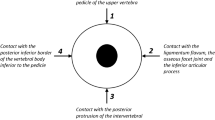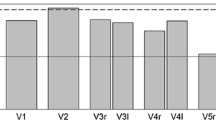Abstract
Background
The purposes of this study were to assess the reliability of 3-dimensional magnetic resonance (MR) imaging (3D MRI) and conventional MRI (CMRI) for detection of lumbar intra and/or extra-foraminal stenosis (LIEFS) and to compare the diagnostic accuracy of the 2 imaging modalities.
Methods
A total of 60 sets of 3D MR and CMR images from 20 healthy volunteers and 40 LIEFS patients were qualitatively rated according to defined criteria by 3 independent, blinded readers. Kappa statistics were used to characterize intra and inter-reader reliability for qualitative rating of data. Multireader, multicase analysis was used to compare lumbar foraminal stenosis detection between the 2 modalities.
Results
Intra-reader agreement for 3D MRI was excellent, with kappa = 0.90; that for CMRI was good, with kappa = 0.78. Average inter-reader agreement for 3D MRI was good, with kappa = 0.79, whereas that for CMRI was moderate, with kappa = 0.41. Average area under the ROC curve values (1st reading/2nd reading) for detection of lumbar foraminal stenosis using 3D MRI and CMRI were 0.99/0.99 and 0.94/0.92, respectively. Detection of LIEFS with 3D MRI was significantly better than with CMRI (P = 0.0408/0.0294).
Conclusions
These results suggest that CMRI was of limited use for detection of the presence of LIEFS. Isolated imaging with CMRI may risk overlooking the presence of LIEFS. In contrast, reliability of 3D MRI for detection of LIEFS was good. Furthermore, readers’ performance in the diagnosis of LIEFS can be improved by use of 3D MRI. Therefore, 3D MRI is recommended when using imaging for diagnosis of LIEFS.




Similar content being viewed by others
References
Burton R, Kirkaldy-Willis W, Yong-Hing K, Heithoff K. Causes of failure of surgery on the lumbar spine. Clin Ortop Relat Res. 1981;157:191–7.
MacNab I. Negative disc exploration: an analysis of the causes of nerve root involvement in sixty-eight patients. J Bone Joint Surg Am. 1971;53(5):891–903.
Kornberg M. Extreme lateral lumbar disc herniations. Spine. 1987;12(6):586–9.
Kunogi J, Hasue M. Diagnosis and operative treatment of intraforaminal and extraforaminal nerve root compression. Spine. 1991;16(11):1312–30.
Cramer GD, Cantu JA, Dorsett RD, Greenstein JS, McGregor M, Howe JE, Glenn WV. Dimension of the lumbar intervertebral foramina as determined from the sagittal plane magnetic resonance imaging scans of 95 normal subjects. J Manipulative Physiol Ther. 2003;26(3):160–70.
Taira G, Endo K, Ito K. Diagnosis of lumbar disc herniation by three-dimensional MRI. J Orthop Sci. 1998;3(1):18–26.
Aota Y, Niwa T, Yoshikawa K, Fujiwara A, Asada T, Saito T. Magnetic resonance imaging and magnetic resonance myelography in the presurgical diagnosis of lumbar foraminal stenosis. Spine. 2007;32(8):896–903.
Lurie JD, Tosteson AN, Tosteson TD, Carragee E, Carrino J, Kaiser J, Blanco Sequeiros RT, Lecomte AR, Grove MR, Pearson LH, Weinstein JN, Herzog R. Reliability of readings of magnetic resonance imaging features of lumbar spinal stenosis. Spine. 2008;33(14):1605–10.
Byun WM, Jang HW, Kim SW. Three-dimensional magnetic resonance rendering imaging of lumbosacral radiculography in the diagnosis of symptomatic extraforaminal disc herniation with or without foraminal extension. Spine. 2012;37(10):840–4.
Jenis LG, An HS. Spine update: lumbar foraminal stenosis. Spine. 2000;25(3):389–94.
Baba H, Uchida K, Maezawa Y, Furusawa N, Okumura Y, Imura S. Microsurgical nerve root canal widening without fusion for lumbosacral intervertebral foraminal stenosis: technical notes and early results. Spinal Cord. 1996;34:644–50.
Wiltse LL, Guyer RD, Spencer CW. Alar transverse process impingement of the L5 spinal nerve: the far-out syndrome. Spine. 1984;9(1):31–41.
Olsewski JM, Simmons EH, Kallen FC, Mendel FC. Evidence from cadavers suggestive of entrapment of fifth lumbar spinal nerves by lumbosacral ligaments. Spine. 1991;16(3):336–47.
Transfeldt EE, Robertson D, Bradfold DS. Ligaments of the lumbosacral spine and their role in possible extraforaminal spinal nerve entrapment and tethering. J Spinal Disord. 1992;6(6):507–12.
Matsumoto M, Chiba K, Nojiri K, Ishikawa M, Toyama Y, Nishikawa Y. Extraforaminal entrapment of the fifth lumbar spinal nerve by osteophytes of the lumbosacral spine. Spine. 2002;27(6):E169–73.
Nathan H, Weizenbluth M, Halperin N. The lumbosacral ligament (LSL), with special emphasis on the “lumbosacral tunnel” and the entrapment of the 5th lumbar nerve. Int Orthop. 1982;6(3):197–202.
Raininko R, Manninen H, Battie MC, Gibbons LE, Gill K, Fisher LD. Observer variability in the assessment of disc degeneration on magnetic resonance images of the lumbar and thoracic spine. Spine. 1995;20(9):1029–35.
Dorfman DD, Berbaum KS, Metz CE. Receiver operating characteristic rating analysis: generalization to the population of readers and patients with the jackknife method. Invest Radiol. 1992;27(9):723–31.
Hills SL, Berbaum KS, Metz CE. Recent developments in the Dorfman–Berbaum–Metz procedure for multireader ROC study analysis. Acta Radiol. 2008;15(5):647–61.
Hosmer DW, Lemeshow S. Assessing the fit of the model. In: Hosmer DW, Lemeshow S, editors. Applied logistic regression. 2nd ed. New York: Wiley; 2000. p. 143–202.
Speciale AC, Pietrobon R, Urban CW, Richardson WJ, Helms CA, Major N, Enterline D, Hey L, Haglund M, Turner DA. Observer variability in assessing lumbar spinal stenosis severity on magnetic resonance imaging and its relation to cross-sectional spinal canal area. Spine. 2002;27(10):1082–6.
Obuchowski NA. ROC analysis. Am J Roentgenol. 2005;184(2):364–72.
Gur D. Technology and practice assessment: in search of a “desirable” statement. Radiology. 2005;234(3):659–60.
Boden SD, Davis DO, Dina TS, Patronas NJ, Wiesel SW. Abnormal magnetic-resonance scans of the lumbar spine in asymptomatic subjects. A prospective investigation. J Bone Joint Surg Am. 1990;72(3):403–8.
Ishimoto Y, Yoshimura N, Muraki S, Yamada H, Nagata K, Hashizume H, Takiguchi N, Minamide A, Oka H, Kawaguchi H, Nakamura K, Akune T, Yoshida M. Associations between radiographic lumbar spinal stenosis and clinical symptoms in the general population: the Wakayama Spine Study. Osteoarthr Cartil. 2013;21(6):783–8.
Ando M, Tamaki T, Kawakami M, Minamide A, Nakagawa Y, Maio K, Enyo Y, Yoshida M. Electrophysiological diagnosis using sensory nerve action potential for the intraforaminal and extraforaminal L5 nerve root entrapment. Eur Spine J. 2013;22(4):833–9.
Iwasaki H, Yoshida M, Yamada H, Hashizume H, Minamide A, Nakagawa Y, Kawai M, Tsutsui S. A new electrophysiological method for the diagnosis of extraforaminal stenosis at L5–S1. Asian Spine J. 2014;8(2):145–9.
Eguchi Y, Ohtori S, Yamashita M, Yamauchi K, Suzuki M, Orita S, Kamoda H, Arai G, Ishikawa T, Miyagi M, Ochiai N, Kishida S, Masuda Y, Ochi S, Kikawa T, Takaso M, Aoki Y, Toyone T, Suzuki T, Takahashi K. Clinical applications of diffusion magnetic resonance imaging of the lumbar foraminal nerve root entrapment. Eur Spine J. 2010;19(11):1874–82.
Acknowledgments
The authors wish to thank Dr Hiroko Ihara, Dr Misato Okouchi, and Mr Yuji Nakao in Wakayama-minami radiology clinic for their technical assistance and for collecting data, and Dr Junji Shiraishi in School of Health Sciences, Kumamoto University for his comment on the study design and interpretation of the data.
Conflict of interest
The authors declare that they have no conflict of interest.
Author information
Authors and Affiliations
Corresponding author
About this article
Cite this article
Yamada, H., Terada, M., Iwasaki, H. et al. Improved accuracy of diagnosis of lumbar intra and/or extra-foraminal stenosis by use of three-dimensional MR imaging: comparison with conventional MR imaging. J Orthop Sci 20, 287–294 (2015). https://doi.org/10.1007/s00776-014-0677-1
Received:
Accepted:
Published:
Issue Date:
DOI: https://doi.org/10.1007/s00776-014-0677-1




